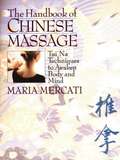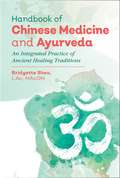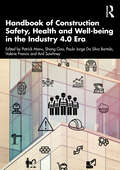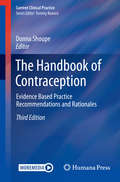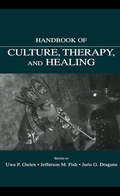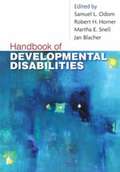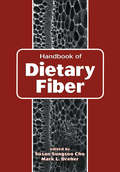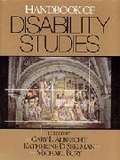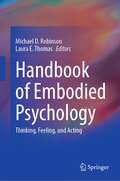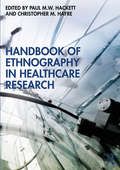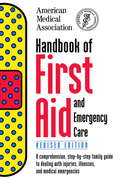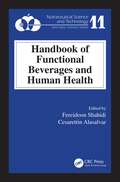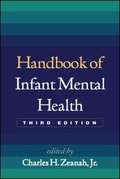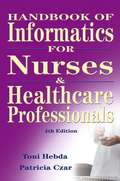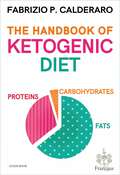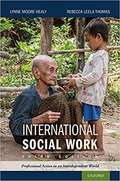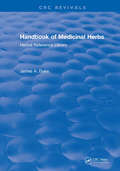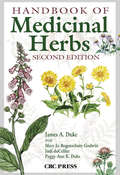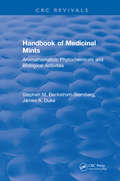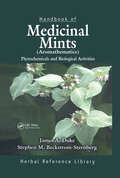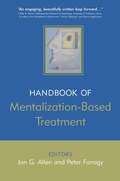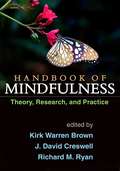- Table View
- List View
The Handbook Of Chinese Massage: Tui Na Techniques To Awaken Body And Mind
by Maria MercatiFor the first time in the West, Chinese tui na massage techniques are brought together in an easy-to-use method for whole-body health <P> The Handbook of Chinese Massage integrates classic Tui Na (meaning push and grasp) techniques used in the Orient for centuries into a revolutionary method for health and well-being. Traditional Chinese massage practitioners use specific individual techniques to treat a wide variety of ailments--techniques demonstrated in this book. But after years of study in China, Indonesia, and Thailand, Maria Mercati has taken these separate techniques and combined them into a whole-body treatment never before seen in East or West. Tui Na massage stimulates the flow of qi, vital energy, in healthy individuals as well as sick ones. It requires no special equipment and is simple enough to do at home or in a chair at work. <P> The Handbook of Chinese Massage includes step-by-step instructions for each of the fifteen unique tui na techniques, many of which are unfamiliar to Western massage practitioners.
Handbook of Chinese Medicine and Ayurveda: An Integrated Practice of Ancient Healing Traditions
by Bridgette SheaA comprehensive reference tool for maximizing healing of the mind, body, and spirit through a holistic synergy of Chinese medicine and Ayurveda • Details the foundational principles of each tradition and the many concepts they share, such as qi and prana, meridians and nadis, and energy centers and chakras • Provides tools for self-assessment including a primer on tongue diagnosis and a mental, emotional, and physical constitutional questionnaire • Offers breathing exercises, dietary regimens, herbal recommendations, and guides for detoxification, including safe and gentle at-home cleansing Chinese medicine and Ayurveda are two of the oldest healing systems in use today. Each is a complete art, in and of itself, and has profoundly contributed to the health and well-being of millions of people around the world. Drawing on their shared roots and spiritual principles, Bridgette Shea, L.Ac., MAcOM, shows how these two practices integrate seamlessly, with the two traditions’ individual strengths harmonizing to form a practical basis for prevention, wellness, detoxification, and treatment. The author explains the foundational principles of both Chinese medicine and Ayurveda in detail, providing the reader with a working understanding of both disciplines. She examines shared concepts such as qi and prana, meridians and nadis, and energy centers and chakras. She explores the strengths of each practice, such as the clinical efficiency of diagnosis and the use of acupuncture for pain relief, improving fertility, and stress reduction in Chinese medicine and the dietary, detoxification, and spiritual guidance of Ayurveda, including the detox branch of Ayurveda known as Panchakarma. Moving beyond theory into practical application, she explores the Elements, known as the Five Phases and the Panchamahabhutas, and how they affect our well-being. She provides tools for self-assessment including a primer on tongue diagnosis and a mental, emotional, and physical constitutional questionnaire. Offering treatment and prevention strategies that draw from both disciplines, she encourages the reader to implement an integrated practice of these two systems in daily life or clinical practice. She details breathing exercises, dietary regimens, herbal recommendations, and guides for detoxification, including safe and gentle home cleanses, all rooted in the holistic synergy between Ayurveda and Chinese medicine. Sharing case studies that highlight the interconnectedness of these approaches, Shea provides a comprehensive guide for self-healing of body, mind, and spirit and a practitioner’s resource to cross-reference complex questions with respect to both healing traditions.
Handbook of Construction Safety, Health and Well-being in the Industry 4.0 Era
by Patrick Manu Shang Gao Paulo Jorge Da Silva Bartolo Valerie Francis Anil SawhneyThis Handbook seeks to examine and advance current understanding of the confluence of construction health, safety and well-being and the broad range of Industry 4.0 technologies in use in the architecture, engineering and construction (AEC) industry. Globally, the construction sector accounts for more than 100,000 occupational fatalities annually. In many countries, reports of work-related accidents, injuries and illnesses are commonplace, and there is an urgent need to improve the occupational safety and health (OSH) outlook of the construction sector. The fourth industrial revolution presents opportunities to leverage modern technologies (e.g., big data, artificial intelligence, automation, sensors, AR, VR and robotics) to improve the poor OSH performance of the construction industry. However, embracing such technologies could also induce unintended adverse consequences for the safety, health and well-being of construction workers. Therefore, the realisation of the opportunities as well as the mitigation of potentially adverse consequences requires research-informed holistic insights around the union of Industry 4.0 and construction occupational safety and health management. This cutting-edge volume addresses a significant gap in literature by bringing together experienced academics and researchers to highlight the drivers, opportunities and drawbacks of the merging of Industry 4.0 with construction health, safety and well-being. After a detailed introductory section which highlights key issues and challenges, section one covers the application of a broad range of digital technologies; then section two discusses the application of industrial production and cyber physical systems in the context of construction safety and health management. Readers from a broad range of AEC backgrounds as well as safety professionals and technologists will come to understand how the technologies are applied and the resulting OSH benefits as well as potential drawbacks.
The Handbook of Contraception: Evidence Based Practice Recommendations and Rationales (Current Clinical Practice)
by Donna ShoupeThis book presents an up-to-date and comprehensive review of female contraception, offering an extensive overview of contraception types, including oral, injectable, emergency, and various cervical barrier contraceptives. It also discusses behavioral and sterilization methods of contraception as well as the clinical effectiveness, advantages, disadvantages, side effects, and mechanisms of action of each method.Now in its fully revised and expanded third edition, this text includes seven new chapters that address specific clinical issues that healthcare providers face daily. These issues include patients with medical problems, perimenopausal women, the adolescent population, post-pregnancy patients, patients with bleeding problems, fibroids or hyperplasia, obese patients and patients with acne or hirutism. There is also a new chapter dedicated to contraceptive methods that are currently in development. Each chapter reviews the correct use of the individual method, the most appropriate candidates, timing of initiation, red flag contraindications, risks and benefits, method of action, handling side effects, non-contraceptive benefits, switching methods and the CDC Medical Eligibility for the method. Importantly however, there is a new emphasis placed on standardized evidence-based practice recommendations incorporating the most recent US Selected Practice Recommendations and rationale as published by the US CDC. Written by experts in the field, The Handbook of Contraception, Third Edition, is a valuable resource for obstetricians, gynecologists, reproductive medicine specialists and primary care physicians.
Handbook of Culture, Therapy, and Healing
by Uwe P. Gielen Jefferson M. Fish Juris G. DragunsEmotional, as well as physical distress, is a heritage from our hominid ancestors; it has been experienced by every group of human beings since our emergence as a species. And every known culture has developed systems of conceptualization and intervention for addressing it. The editors have brought together leading psychologists, psychiatrists, anthropologists, and others to consider the interaction of psychosocial, biological, and cultural variables as they influence the assessment of health and illness and the course of therapy. The volume includes broadly conceived theoretical and survey chapters; detailed descriptions of specific healing traditions in Asia, the Americas, Africa, and the Arab world. The Handbook of Culture, Therapy, and Healing is a unique resource, containing information about Western therapies practiced in non-Western cultures, non-Western therapies practiced both in their own context and in the West.
Handbook of Developmental Disabilities
by Samuel L. Odom Robert H. Horner Martha E. Snell Jan BlacherIn this reprint from 2007, Odom (child development, U. of North Carolina at Chapel Hill) et al. bring together 30 chapters reviewing current knowledge about different dimensions of developmental disabilities, neuroscientific and genetic foundations, impacts on health, learning, and behavior, and educational and clinical practices. Scholars of education, human development, psychiatry, psychology, learning disabilities, and other areas, who are based in North America and the UK, discuss definition and classification issues, social policy, research methods, cultural influences, and established and new approaches to promoting communication and language abilities, academic skills, positive social interactions, vocational and independent living skills, and positive behavior support, family adaptation, and resilience with children and adults. Other topics include dual diagnosis, pharmacological and behavioral treatments, families, and international perspectives and practices. Annotation c2009 Book News, Inc., Portland, OR (booknews.com)
Handbook of Dietary Fiber: An Applied Approach (Food Science And Technology Ser. #Vol. 25)
by Susan Sungsoo Cho; Mark L. DreherPresents the latest research on the analysis, metabolism, function, and physicochemical properties of fiber, fiber concentrates, and bioactive isolates--exploring the effect of fiber on chronic disease, cardiovascular health, cancer, and diabetes. Examines food applications and the efficacy and safety of psyllium, sugar beet fiber, pectin, alginate, gum arabic, and rice bran.
Handbook of Disability Studies
by Gary L. Albrecht Katherine D. Seelman Michael BuryDrawing on the insights of disability scholars around the world and the creative advice of an international editorial board, this book engages the reader in the critical issues and debates framing disability studies and places them in an historical and cultural context. Five years in the making, this one volume summarizes the ongoing discourse ranging across continents and traditional academic disciplines.
Handbook of Embodied Psychology: Thinking, Feeling, and Acting
by Michael D. Robinson Laura E. ThomasThis edited volume seeks to integrate research and scholarship on the topic of embodiment, with the idea being that thinking and feeling are often grounded in more concrete representations related to perception and action. The book centers on psychological approaches to embodiment and includes chapters speaking to development as well as clinical issues, though a larger number focus on topics related to cognition and neuroscience as well as social and personality psychology. These topical chapters are linked to theory-based chapters centered on interoception, grounded cognition, conceptual metaphor, and the extended mind thesis. Further, a concluding section speaks to critical issues such as replication concerns, alternative interpretations, and future directions. The final result is a carefully conceived product that is a comprehensive and well-integrated volume on the psychology of embodiment. The primary audience for this book is academic psychologists from many different areas of psychology (e.g., social, developmental, cognitive, clinical). The secondary audience consists of disciplines in which ideas related to embodied cognition figure prominently, such as counseling, education, biology, and philosophy.
Handbook of Emergency Cardiovascular Care for Healthcare Providers
by Mary Fran Hazinski Ricardo Samson Steve SchexnayderThe 2010 edition of the Handbook of Emergency Cardiovascular Care for Healthcare Providers incorporates the latest science and treatment recommendations from the 2010 American Heart Association Guidelines for CPR & ECC. <P><P> This pocket-sized reference tool, highly-popular among healthcare professionals, provides convenient, quick access to the latest resuscitation science and treatment information. The handbook is organized by basic, advanced adult and pediatric life support and newborn resuscitation. It provides algorithms, protocols, sequences, drug dosages, and much more. The Handbook of ECC is often included on hospital crash charts and accessed frequently in the field by EMS and other first responders.
Handbook of Ethnography in Healthcare Research
by Hackett, Paul M.W.This handbook provides an up-to-date reference point for ethnography in healthcare research. Taking a multi-disciplinary approach, the chapters offer a holistic view of ethnography within medical contexts. This edited volume is organized around major methodological themes, such as ethics, interviews, narrative analysis and mixed methods. Through the use of case studies, it illustrates how methodological considerations for ethnographic healthcare research are distinct from those in other fields. It has detailed content on the methodological facets of undertaking ethnography for prospective researchers to help them to conduct research in both an ethical and safe manner. It also highlights important issues such as the role of the researcher as the key research instrument, exploring how one’s social behaviours enable the researcher to ‘get closer’ to his/her participants and thus uncover original phenomena. Furthermore, it invites critical discussion of applied methodological strategies within the global academic community by pushing forward the use of ethnography to enhance the body of knowledge in the field. The book offers an original guide for advanced students, prospective ethnographers, and healthcare professionals aiming to utilize this methodological approach.
Handbook of First Aid and Emergency Care, Revised Edition
by American Medical AssociationHow to use this bookWhen a medical emergency strikes, what you do can mean the difference between life and death. The American Medical Association Handbook of First Aid and Emergency Care, Revised Edition, gives you all the information you need--quickly, easily, clearly--so that you can make the difference.Key features include the most up-to-date emergency care information: ¸ the newest CPR positions and techniques to be used on infants, children, and adults ¸ first-aid and lifesaving techniques you can practice so you're prepared when an emergency strikes ¸ injuries, illnesses, and medical emergencies: an alphabetical listing to help you find the information you need quickly ¸ easy-to-follow instructions and clear line drawings that walk you through each step ¸ what happens in the emergency room; knowing when to call your doctor or the hospital and what information to have ready ¸ sports injuries: treatment and recovery, especially for the amateur, school, or weekend athlete ¸ a chart to be filled in for each family member to list medical information, such as allergies and immunizations, to have on hand for emergency situations ¸ a comprehensive index, with complete listings by subject and symptom for fast reference
Handbook of Functional Beverages and Human Health (Nutraceutical Science and Technology)
by Fereidoon Shahidi Cesarettin AlasalvarHandbook of Functional Beverages and Human Health provides potential applications and new developments in functional beverages, nutraceuticals, and health foods. In addition to serving as a reference manual, it summarizes the current state of knowledge in key research areas and contains novel ideas for future research and development. Additionally,
Handbook of Functional Neuroimaging of Cognition
by Roberto Cabeza Alan KingstoneThe theoretical and methodological developments in the use of functional neuroimaging techniques to study the neural basis of cognition, from early scientific efforts to link brain and behavior to the latest applications of fMRI and PET methods.
Handbook of Infant Mental Health
by Charles H. ZeanahWidely regarded as the standard reference in the field, this state-of-the-art Handbook offers a comprehensive analysis of developmental, clinical, and social aspects of mental health from birth to the preschool years. Leading authorities explore models of development; biological, family, and sociocultural risk and protective factors; and frequently encountered disorders and disabilities. Evidence-based approaches to assessment and treatment are presented, with an emphasis on ways to support strong parent-child relationships. The volume reviews the well-documented benefits of early intervention and prevention and describes applications in mental health, primary care, childcare, and child welfare settings. The chapter on psychopharmacology has been updated for the paperback edition.
Handbook of Informatics for Nurses & Healthcare Professional (4th edition)
by Toni Lee Hebda Patricia Czar Toni HebdaThis useful handbook introduces nurses and other health care professionals to the most current application of computer-related technology in the health care environment. Included are the various forms of electronic communication and ways to use it more effectively. New coverage of web-based technology, search tools, and evaluation criteria for online material are presented along with regulatory and accreditation requirements, such as HIPAA. Completely updated, the fourth edition offers a clearly written overview of informatics, as well as practical applications of computer-based education for day-to-day use.
Handbook of Insulin Therapies
by Winston Crasto Janet Jarvis Melanie J. DaviesA clinically-focused handbook that provides an overview of the different types of insulin, delivery methods, emerging treatments, and cutting-age devices. The aim of the handbook is to discuss insulin treatment strategies that can improve glucose control, enhance patient adherence, and minimize adverse effects and disease-related complications. Concise scope and size is ideal for busy healthcare professionals that regularly encounter patients with diabetes and require an up-to-date snapshot of advances in diabetes care.
The Handbook of Ketogenic Diet
by Fabrizio P. CalderaroThe ketogenic diet is more popular than ever — for a reason! This form of nutrition turns our organism into a fat burning machine and at the same time fights the most common diseases such as arteriosclerosis, high blood pressure, diabetes mellitus, obesity and others in an impressive way. The fact that our organism is capable of ketogenesis has ensured the survival of our ancestors in evolutionary development. Therefore, ketosis must be understood as an absolutely physiological process. This book not only provides the reader with detailed background information, but also deals with the special features and scientific aspects of ketosis. It creates a complex understanding of the topic and facilitates the path to a comprehensive, independent and successful change in diet.
Handbook of Life-Span Development
by Karen L. Fingerman Cynthia A. Berg Jacqui Smith Toni C. AntonucciThe doubling of our average life span since the turn of the 20th century is considered by many scholars to be one of the most important changes in human existence. This definitive text is the only volume to fully address, through a multidisciplinary perspective, the biological, cognitive, and psychological development that occurs from infancy through old age, and how the sociocultural and institutional factors interface with these changes. <p><p> Edited by leading research scholars in the field of life-span development, the volume also includes contributions of specialists in behavioral genetics, socioemotional selectivity theory, neuroscience, ecological models, and more. It examines the dynamics of close relationships and informal ties among the elderly population, child-parent attachment relationships as a life-span phenomenon, developmental tasks across the lifespan, continuity and discontinuity in temperament and personality, the sociocultural context of cognition across the life span, and variability in approaches to social problem solving from early to later life. Given the number of recent demographic shifts, it also explores issues related to fertility, life expectancy, environmental contexts, technology, immigration, and public policy.
Handbook of Medicinal Herbs: Herbal Reference Library
by James A. DukeA Practical, Authoritative CompendiumThis handbook catalogs 365 species of herbs having medicinal or folk medicinal uses, presenting whatever useful information has been documented on their toxicity and utility in humans and animals. Plants from all over the world - from common cultivars to rare species - are included in these 700 pages. The toxicity of these species varies, but the safety of each has been formally or informally questioned by the Food and Drug Administration, National Cancer Institute, Department of Agriculture, Drug Enforcement Administra-tion, or Herb Trade Association.Easy-to-Locate Facts and FiguresDesigned to enable fast access to important information, this hand-book presents information in both catalog and tabular forms. In the catalog section, plants are presented alphabetically by scientific name. (The index permits you to locate an herb by its common name.) A detailed sketch of the chief identifying features accompa-nies most catalog entries. For each species the following information, as available, is presented and referenced:Family and colloquial namesChemical contentUses and applications - present and historicalProcessing, distribution, and economic potentialToxicological agents and degree of toxicityPoison symptoms in humans and animalsTreatment and antidotes References to original literatureFive Tables of Accessible DataGiven a plant species, you can easily determine its toxins; or, given a toxin, you can discover which plants contain it. These and other data are presented in convenient tabular formats as appendixes to the handbook. Other information contained in these tables include toxicity ranking and other toxicity data (as applicable), such as mode of contact, organs affected, and lethal dose; and proximate analyses of selected foods. These tables are titled:Medicinal Herbs: Toxicity Rank
Handbook of Medicinal Herbs
by James A. DukeStill considered the definitive work on medicinal herbs and their uses after two decades, the Handbook of Medicinal Herbs has undergone a long-anticipated revision. In the second edition, world-renowned ethnobotanist James A. Duke provides up-to-date data on over 800 of the world's most important medicinal plant species. The book contains mo
Handbook of Medicinal Mints: Aromathematics: Phytochemicals and Biological Activities
by Stephen M Beckstrom-SternbergInterest in herbal medicines, aromatherapy, and other traditional applications of aromatic plants has increased tremendously over the last few years. However, very little "hard data" on the properties and uses of these plants has been available until now. This handbook provides the most complete collection of chemical data available on aromatic mints (Lamiaceae). The authors introduce the new field of study, aromathematics, which involves aromatic compounds and their biological activities. This book contains a wealth of quantitative data, including more than 500 references on 10,839 chemicals from 251 assays of 205 unique taxa, combined with 3,324 biological activities and 256 recommended daily allowances and lethal doses. An exhaustive guide, the handbook is the ultimate resource for assessing the potential medicinal value of a particular species.
Handbook of Medicinal Mints ( Aromathematics): Phytochemicals and Biological Activities, Herbal Reference Library
by James A. Duke Stephen M Beckstrom-SternbergThis handbook provides the most complete collection of chemical data available on aromatic mints (Lamiaceae). The authors thoroughly introduce the field of aromathematics. Handbook of Medicinal Mints (Aromatics): Phytochemicals and Biological Activities contains a wealth of quantitative data, including more than 500 references on 10,839 chemicals from 251 assays of 205 unique taxa, combined with 3,324 biological activities and 256 recommended daily allowances and lethal doses. An exhaustive guide, the handbook is the ultimate resource for assessing the potential medicinal value of a particular species.
Handbook of Mentalization-Based Treatment
by Jon G. Allen Peter FonagyPioneering research has been carried out over the last decade on mentalization and the promotion of mentalizing capacity - the ability to interpret the behavior of oneself and others as based on intentional mental states, such as needs, desires, feelings, and beliefs. This book is a consolidation of current knowledge and clinical applications, bringing together a group of international experts who have been on the ground floor of theory and research to clarify the concept, review pertinent neurobiological and psychosocial research, and explore its diverse clinical applications. Four sections will cover Conceptual Foundations, Developmental Psychopathology, Intervention and Prevention. A biopsychosocial approach will be used, integrating new research in neuroimaging with psychodynamic and cognitive perspectives. Clinical issues covered will include parent?child interactions, personality disorders, traumatic brain injury, bullying and at-risk children.
Handbook Of Mindfulness: Theory, Research, And Practice
by Kirk Brown J. Creswell Richard RyanAn authoritative handbook, this volume offers both a comprehensive review of the current science of mindfulness and a guide to its ongoing evolution. Leading scholars explore mindfulness in the context of contemporary psychological theories of attention, perceptual processing, motivation, and behavior, as well as within a rich cross-disciplinary dialogue with the contemplative traditions. After surveying basic research from neurobiological, cognitive, emotional/affective, and interpersonal perspectives, the book delves into applications of mindfulness practice in healthy and clinical populations, reviewing a growing evidence base. Examined are interventions for behavioral and emotion dysregulation disorders, depression, anxiety, and addictions, and for physical health conditions.
